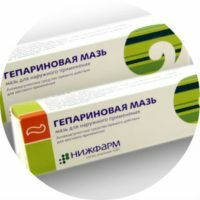
It is impossible to insure against bruises and injuries, and therefore in the first aid kits there are very often drugs that help get rid of the usual bruises. Heparin ointment is a remedy that can not only accelerate the disappearance of bruises. It can help in the treatment of more serious diseases.
- Pharmacological action
- Composition
- Indications
- Methods
- therapeutic use
- Hemorrhoids
- When varicose
- In
- dentistry for bruises and injuries
- The cosmetic
- From
- swelling from bruises
- From
- wrinkles for hair growth
- Interaction withother drugs
- Contraindications
- Side effects of
- Analogs
- Lyoton 1000
- Fraksiparin
- Warfarin
- Sinkumar
Pharmacological action
Heparin -this substance prevents the coagulability of blood, changing its viscosity( anticoagulant direct action).Heparin is released from the ointment gradually and reduces the inflammatory process, reduces the adhesion of platelets among themselves. It has an antithrombotic effect( promotes resorption of thrombi and prevents the formation of new ones).Inhibits the activity of enzymes that can cleave hyaluronic acid.
Benzonicotinic acid expands the surface of the vessels, facilitating the absorption of heparin.
Anestezin in the composition of the ointment reduces pain. Has a local anesthetic effect.
Composition
Substances that make up the heparin ointment:
- sodium heparin( anticoagulant);
- benzonicotinic acid( improves the absorption of heparin);
- anesthesin( analgesic effect);
- Vaseline( base);
- glycerol( protective and emollient);
- peach oil( contains fatty acids and vitamins of group B and E);
- nipazel, nipagin( preservatives);
- stearin( emulsifier, stabilizer);
- distilled water.
Indications
Heparin ointment is prescribed in the following cases:
- treatment and prophylaxis of varicose veins symptoms( thrombophlebitis, thrombosis);
- inflammation of the walls of veins and surrounding tissues;
- mastitis;
- inflammation of the puerperium hemorrhoids;
- external hemorrhoids;
- subcutaneous hematomas, edema;
- injuries and bruises of muscles, tendons, and joints.
- trophic ulcers of the lower leg;
- is an inflammation of the lymph nodes.
Methods of application
Apply a thin layer of heparin ointment( to avoid overdose) on the affected area and gently rubbed into the skin 3 times a day. The effect of the ointment lasts up to 8 hours. The course of treatment is from 3 to 7 days, sometimes more.
For therapeutic purposes
to the table of contents ^For hemorrhoids
Ointment should be applied to a cotton swab and superimposeddirectly to the nodes. The course of treatment is not more than 7 days.
for table of contents ^For varicose
Heparin ointment should be applied gently. Do not stretch the affected areas. Intensive rubbing can lead to the spread of inflammation and can provoke the detachment of the formed blood clots.
to contents ^In dentistry
The drug is used for periodontal disease, to relieve edema, reduce pain and improve blood microcirculation. The ointment is applied to a cotton swab and applied to the gum.
In case of bruises and injuries
Ointment is not applied immediately, but the next day. When applying, avoid open wounds.
to table of contents ^In cosmetic
Often women use heparin ointment for cosmetic purposes. Auxiliary substances, such as peach oil, glycerin, really have a beneficial effect on the skin. Heparin ointment slows down aging, eliminates the manifestation of a vascular network on the face, in combination with vitamins A, C, E well moisturizes the skin.
It should be remembered that heparin ointment is a medicinal product and it can not be abused. It is advisable to use the product only as directed by the doctor.
to table of contents ^From edema
Heparin ointment is used to remove swelling under the eyes. Edema occurs due to the accumulation of interstitial fluid. The skin around the eyes is very thin and delicate, it can easily be injured. Therefore, the ointment is applied very gently, with fingertips, patting movements. Avoid contact with ointment in the eyes. Use the tool can be no more than 1 time per day.
to contents ^From bruises
Ointment promotes resorption of bruises and removes pain. Apply it to a thin layer 2-3 times a day on the affected area. The smaller the bruise, the faster it will come down.
From wrinkles
Cosmetologists say that heparin ointment helps to get rid of wrinkles. A small amount of ointment is applied on the palm of your hand, and then lightly patted onto the cleansed face. This procedure is carried out 2 times a day( in the morning and in the evening) for a week.
to table of contents ^For hair growth
- heparin ointment - ½ teaspoon;
- vitamins A and E in oil - 2 teaspoons each;
- lemon juice - 2 teaspoons.
All the ingredients are mixed, applied to the roots of hair, put on a plastic cap, warm it. Keep mask for 1 hour. Apply once a week.
to contents ^Interaction with other drugs
Some drugs are able to reduce or even neutralize the action of heparin. It is not recommended to use ointment in combination with the following drugs:
- antihistamine( used for allergic reactions);
- alkaloids( used to treat migraine and in gynecology);
- thyroxine( used to treat various thyroid diseases);
- antibiotic tetracycline( used to treat diseases of the genitourinary system, upper respiratory tract).
Smoking and alcohol reduce the effects of heparin.
to table of contents ^Contraindications
- Ulcers, wounds, deep cuts, bruises with irritated skin. Applying the ointment in this case can lead to bleeding. Ointment slows the formation of connective tissue and slows healing.
- Congenital diseases associated with bleeding disorders.
- Increased vascular permeability.
- Allergy to one of the components. Before use, apply a small amount of ointment to a small area of the skin. With itching and redness, the ointment should be washed off and discarded.
- Age under 18 years. But sometimes traumatologists and pediatricians prescribe this drug to children from 1 year, if there is no individual intolerance.
- Pregnancy and lactation.
Side effect of
Overdose of heparin can lead to the following side effects:
- Bleeding. It is necessary to consult a doctor immediately.
- Itching, hives, dermatitis. Stop use. Replace with another drug.
Analogs of
to table of contents ^Lyton 1000
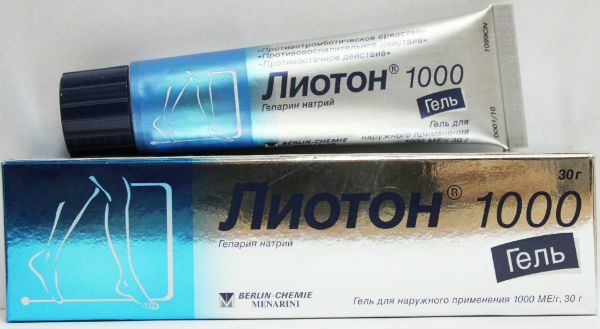
The active ingredient is sodium heparin. Application: blockage of veins and inflammation of the walls, chronic varicose veins, varicose ulcers, recovery period after operations on the veins, tissue tightening, swelling, bruises, bruises.
Contraindications: Hypersensitivity to the components of the drug, thrombocytopenia, violation of the integrity of the skin at the site of application.
Side effects: rash, allergic reactions.
to contents ^Frakssiparin
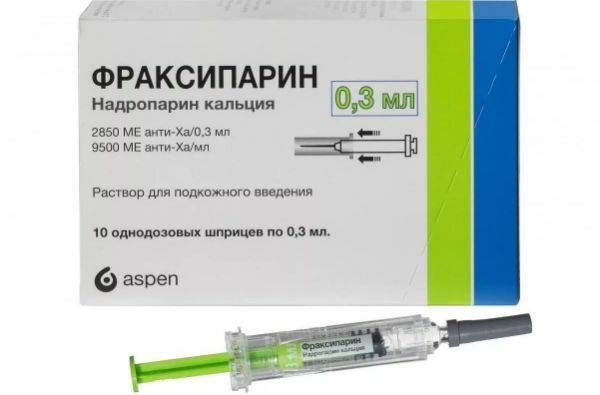
The active ingredient is calcium supraparin. Application: prevention of thromboembolic complications associated with general surgery, oncology and orthopedics, prevention of blood coagulation during hemodialysis, treatment of thrombosis and thromboembolism, unstable angina and myocardial infarction.
Contraindications: thrombocytopenia, hemostasis, gastric or duodenal ulcer, severe renal failure, age under 18 years.
Side effects: bleeding, rash, allergic reactions.
to contents ^Warfarin
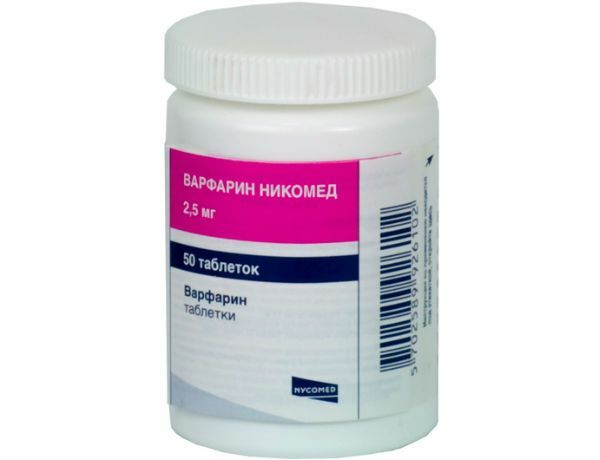
The active substance is warfarin. Application: treatment and prevention of vein thrombosis, postoperative thrombosis, myocardial infarction. Long-term treatment is recommended for prosthetic valve valves and vessels.
Contraindications: peptic ulcer disease, impaired liver and kidney function, pregnancy and lactation.
Side effects: possible nausea, vomiting, diarrhea, abdominal pain, increased hepatic activity, allergic reactions.
to contents ^Syncumar
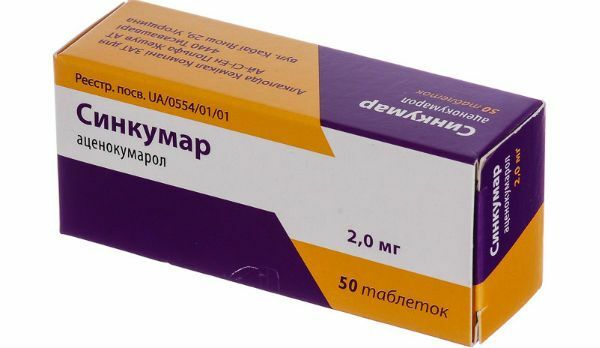
The active ingredient is acenocoumarol. Application: reduction of blood clotting in the prevention and treatment of thrombosis, thrombophlebitis, thromboembolic complications in myocardial infarction and embolic strokes. Cinkumar is used as an additional agent in the treatment with heparin.
Contraindications: hemorrhagic diathesis, renal failure, impaired liver function, high blood pressure, pregnancy and lactation, diabetic retinopathy, hypovitaminosis K and C.
Side effects: nausea, diarrhea, headache, allergic reactions.
